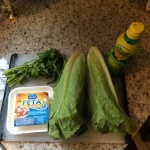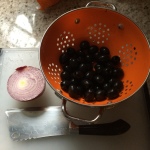We’ve got two recipes to get more salad into your diet: Greek Salad and a Vinaigrette Dressing. We also have lettuce growing, storage and preparation tips from our Vermont Fresh: A Fruit and Vegetable Handbook.
Ada Bagalio, a volunteer cooking, tasting and testing recipes out of the Vermont Fresh Handbook tested the recipes. Her comments are below in italics.
Background
Lettuce, one of the world’s most popular vegetables, is a leafy plant that is most commonly eaten raw in salads. While most people are familiar with only a few kinds of lettuce, such as iceberg and romaine, there are actually hundreds of varieties. Lettuce can be divided into five distinct categories: butterhead, crisphead, loose-leaf, romaine, and stem (or “Chinese”) lettuce. It is believed that the ancient Egyptians grew lettuce alongside some of the world’s first cultivated crops thousands of years ago. Modern lettuce cultivars descended from a variety of wild lettuce that is native to Asia. For the home grower, it is worth pursuing some of the lesser-known varieties of lettuce. Industrial agriculture tends to favor firm, hardy lettuce varieties that can be shipped and stored with little damage, which has unfortunately led to the decline of some much tastier lettuces.
Growing Tips
Lucky for New Englanders, almost all varieties of lettuce prefer cooler temperatures. Lettuce can be seeded directly into the garden as soon as the soil can be easily worked, but lettuce can also be started indoors and transplanted. If you are growing a leafy salad mix, however, transplanting is not recommended—it works much better for heading lettuces. Avoid planting outdoors when there is still a risk for consistent hard frosts. Most lettuce varieties reach maturity in less than two months, so if you plant in May, you will certainly be feasting by July! Be sure to stagger lettuce plantings to avoid an overabundance all at once. Starting a few heads every two weeks will ensure a steady supply. Lettuce may not germinate well in hot temperatures and it will also become bitter during periods of extended heat or drought, so keep it well watered. Pick once mature to avoid bolting.
Storage
Heads of lettuce can be stored unwashed, wrapped loosely in plastic, in the crisper drawer of your refrigerator. Wet lettuce will deteriorate quickly, so if you purchase sopping leaves, spin them dry or wrap them in a paper towel to absorb excess moisture before refrigerating. Use as soon as possible—lettuce lasts only days.
Nutritional Benefits
Lettuce is made up almost entirely of water, which helps explain why it is so refreshing in the summer heat. It also contains vitamins A and C, beta carotene, and folic acid.
Preparation
Lettuce should always be washed before eating. For especially gritty lettuce, fill a large bowl with cold water and throw in the lettuce leaves (it’s easier to washed leaves than the whole head). Swirl them around, then dry in a salad spinner or, if you don’t have one, shake vigorously in a colander and then gently blot with a clean dish towel.
Meatless Monday Recipe: Basic Vinaigrette Dressing
Ingredients
- ½ cup balsamic vinegar
- 2 teaspoons maple syrup or brown sugar
- 2 teaspoons garlic
- 1 teaspoon salt
- ½ teaspoon pepper
- 1 cup good quality olive oil
Instructions
- Pour all ingredients into a mason jar or a used salad dressing bottle.
- Shake vigorously to combine.
- Serve over green salads. Refrigerate after using. If the oil solidifies, microwave the dressing for a few seconds before using again (or let it sit out on the counter briefly).
Note: Adjust proportions to taste—some may find the amount of vinegar in this recipe to be too much. You can also spice up this dressing by adding a few of your favorite seasonings!
Total Time: 15 minutes
Level: Easy
Rating: Good **** 4 stars
Recommendation – works best with less balsamic vinegar (oil & vinegar) 3 to 1 ratio; 1/3 cup vinegar to 1 cup oil. Use more Maple or brown sugar to taste.
Meatless Monday Recipe: Greek Salad
Serves 6
Ingredients
- 2 tomatoes, diced
- 1 large cucumber, diced
- 1 bell pepper, diced
- ½ cup olives, split in half
- ½ red onion, diced
- Basic vinaigrette dressing (above)
- Splash of lemon juice
- Handful of fresh parsley, chopped (optional)
- 6-8 cups lettuce, chopped or torn into pieces
- ¼ cup crumbled feta cheese
Instructions
Put tomatoes, cucumber, pepper, olives, and onion in a large bowl and toss lightly with a splash of the vinaigrette.
Sprinkle with lemon juice and add parsley if desired.
If not serving immediately, refrigerate for up to two hours, otherwise: Put lettuce in a large salad bowl. Toss with a splash of dressing, then top with veggie mixture. Sprinkle with feta cheese and serve promptly.
Total Time: 30 minutes
Yield: 4-6 servings
Level: Easy
Rating: Excellent *****5 stars
To receive more recipes and tips on your favorite fruits and vegetables, download Vermont Fresh: A Fruit and Vegetable Handbook. We also need more volunteer home chefs for this project.
Vermont Foodbank fresh food initiatives would not be possible without your support. Please consider giving to the Vermont Foodbank today!




